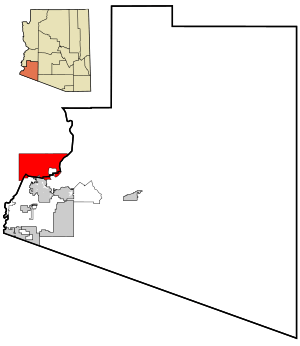Quechan language facts for kids
Quick facts for kids Quechan |
||||
|---|---|---|---|---|
| Yuma Kwatsáan Iiyáa |
||||
| Native to | United States | |||
| Region | California, Arizona | |||
| Ethnicity | c. 10,000 Quechan | |||
| Native speakers | 290 (2015 census)e19 | |||
| Language family |
Yuman
|
|||

Yuma County with Fort Yuma Indian Reservation, where Quechan is spoken, highlighted
|
||||
|
||||
Quechan, also called Kwtsaan or Kwatsáan Iiyáa, is the special language of the Quechan people. They live in southeastern California and southwestern Arizona. This area is near the Lower Colorado River Valley and the Sonoran Desert.
Even though its name sounds like "Quechua," it's important to know that Quechan is not related to the Quechua language spoken in the Andes mountains. Quechan belongs to the River branch of the Yuman language family. Other languages in this family include Mohave and Maricopa.
Contents
Quechan Language: A Living Heritage
Who Speaks Quechan?
In 1980, experts thought fewer than 700 people spoke Quechan. This included both older and younger speakers. By 1994, some believed there were about 150 to 500 speakers.
Good news came in 2009! About 93 young children in preschool were learning Quechan. This was part of the Quechan tribe's program to keep their language alive. At that time, around 100 people were fluent speakers. A Quechan dictionary was also being created.
People who speak Quechan meet every year at the Yuman Family Language Summit. This event has been happening since 2001. It helps keep their language and culture strong.
Stories and Songs in Quechan
A film from 2010 called “Songs of the Colorado” features traditional songs in Quechan. The filmmaker, Daniel Golding, explained that the songs tell stories. He said, "The songs are all sung in the language. If you don't learn the language, you won't understand the songs." This shows how important the language is to their traditions.
If you speak Quechan, you can get help to vote in elections. This help is available in Imperial County, California and Yuma County, Arizona. This right is protected by the Voting Rights Act of 1965.
The Sounds of Quechan
Every language has its own unique sounds, and Quechan is no different! It has five main vowel sounds, like the 'a' or 'e' in English. Each of these can be short or long, which changes the meaning of a word. For example, ʔa·vé means "snake," but ʔa·vé· means "mouse."
Quechan also has many consonant sounds. Some of these sounds are similar to English, while others are special to Quechan. These sounds combine in different ways to form words.
How Quechan Words Work
Quechan words are built in interesting ways. They usually have a main part, called a "theme," which gives the basic meaning. Then, smaller pieces, called "affixes," are added to the theme. These affixes can be placed at the beginning or end of the word.
For example, if you want to say "I see," you might add a special piece for "I" to the word for "see." This is how Quechan shows who is doing the action.
Sometimes, parts of a word are repeated. This is called "reduplication." It can change the meaning to show that something happens many times. For instance, a word meaning "to have a spot" can be repeated to mean "to be spotted all over."
Sentence Structure
In Quechan, sentences usually follow a specific order. They typically put the subject (who or what is doing the action) first. Then comes the object (who or what the action is done to). Finally, the verb (the action word) comes at the end. This is known as a subject-object-verb word order.
A Story in Quechan
Here is a small part of a traditional Quechan story. It is called "The Man Who Bothered Ants." You can see the Quechan words on one side and their English meaning on the other.
|

